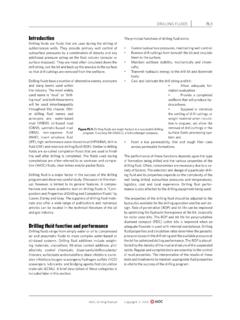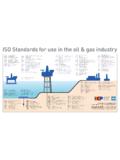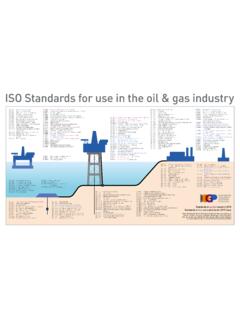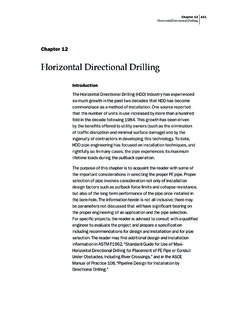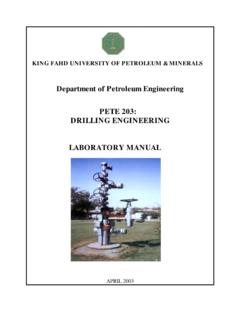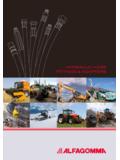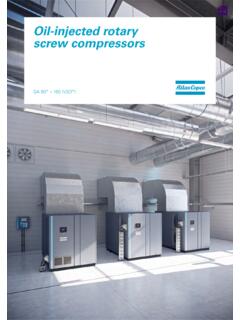Transcription of CO2 Enhanced Oil Recovery - Global Energy Institute
1 Institute for 21st Century Energy | Chamber of CommerceInstitute for 21st Century Energy | Chamber of Enhanced Oil RecoveryThe mission of the Chamber of Commerce s Institute for 21st Century Energy is to unify policymakers, regulators, business leaders, and the American public behind a common sense Energy strategy to help keep America secure, prosperous, and clean. Through policy development, education, and advocacy, the Institute is building support for meaningful action at the local, state, national, and international Chamber of Commerce is the world s largest business federation representing the interests of more than 3 million businesses of all sizes, sectors, and regions, as well as state and local chambers and industry Enhanced Oil Recovery | 1CO2 Enhanced Oil RecoveryEXECUTIVE SUMMARYE nergy, particularly the products that come from crude oil, is an every day part of our lives.
2 From the direct use of gasoline to fuel transportation to the obvious items such as medicines, plastics, and other materials that people use daily, oil fuels our economy. Yet most Americans have little understanding of where oil originates and share a common misperception that the majority of oil imports come from the Middle surprises many people that domestic production is the largest single source of crude oil for our country! The is the third largest oil producer in the world, and its production is growing. Even more important, the is the leader in technology advancements in petroleum President Obama s 2012 State of the Union address, he challenged the country with the statement, This country needs an all-out, all-of-the-above strategy that develops every available source of American Energy .
3 One of the tremendous resource endowments in the is its oil reserves combined with its ability to apply and advance technology for oil production. It is this combination that has resulted in the leading the world in Carbon Dioxide Enhanced Oil Recovery (CO2 EOR).CO2 EOR is an important component of oil production, accounting for nearly 6% of onshore oil production, or 350,000 barrels a This technique uses CO2, both naturally occurring as well as a byproduct of industrial processes, to increase the production of oil from existing oil fields. While CO2 EOR is already an important component of today s oil production, it has great potential to expand production.
4 An analysis commissioned by the Department of Energy (DOE) projects potential oil resources recoverable with CO2 EOR of up to 137 billion barrels, with 67 billion barrels economically recoverable at a price of $85 a barrel. This represents more than three times the current proven terms of economic and Energy security, this means billions of dollars of new investment in the and production potential of 4 million barrels a day of oil for 50 years from existing oil fields. The investment required would not just be in oil fields themselves, but also in power plants, pipelines, and other industries that can capture CO2 from their industrial processes. The economic benefits will also flow to the state and federal governments, with an estimated $ trillion in new government revenues.
5 In addition to the direct benefits in the , the technology used to produce this additional oil will help maintain leadership This country needs an all-out, all-of-the-above strategy that develops every available source of American Energy . President Obama2 | Institute for 21st Century Energyin oil production technology, creating opportunities around the world for EOR has direct environmental benefit. Greatly expanding CO2 EOR will require approximately 20 billion metric tons of CO2. While continued use of naturally occurring CO2 is critical to current development since it represents more than 90% of the CO2 that is available, large volumes of commercially available CO2 captured from industrial and power plant sources have the potential to produce billions of additional barrels of trapped oil and gas.
6 The spent $330 billion on crude oil imports in 2011, representing 60% of the total trade deficit. CRSC aptured CO2 also has the added environmental benefit of not being released into the atmosphere. After the completion of EOR activities, the CO2 used in oil Recovery is permanently sequestered in the old oil formation. CO2 EOR does not require extensive new land impacts because it is primarily applied to existing oil fields. This process increases the efficiency and conservation of the oil resources by producing more oil with the same land impact or footprint . CO2 EOR advances Energy production, Energy security, and environmental sustainability. It is truly a win-win-win OIL EXPLORATION AND PRODUCTION Where does oil come from?
7 Oil is called a fossil fuel because it originated as material from plants and animals that lived millions of years ago. These plants and animals lived in an ocean environment and when they died, this carbon-based (organic) plant and animal material settled on the bottom and mixed with sand, silt, and sediment. Over thousands of years, additional layers of sentiment accumulated and turned into sedimentary rocks, such as sandstone, limestone, and shale. Pressure, temperature, and time resulted in the transformation of the deposited organic material turning into hydrocarbons, such as oil and natural oil and natural gas that is formed in the rock exists in the pore space of the rock formations.
8 Pore space is the open area between the solid grains of material that make up the rock. For example, when water is poured on a piece of sandstone, it is absorbed by the stone it is flowing into the pore spaces which exist between the sand grains that make up the sandstone rock. The measure of the open space in the rock is called porosity. How well the pore spaces are interconnected determines how quickly and effectively fluids flow through the rock. The measure of this interconnectedness is called nature, oil and gas flow from the original rock formation in which they were created (source rock) until it reaches a rock formation with very low permeability.
9 Then the oil and natural gas are trapped. It is the oil and natural gas in these traps that have enabled economic development of oil and natural gas resources for the last 150 years. Just as oil and gas have been trapped beneath caprock for millennia, the injected CO2 from the EOR process will also be trapped by the same geologic mechanism for millennia. For purposes of CO2 EOR, this paper focuses on these types of oil reservoirs. However, new technology has enabled production from the source rock itself in the case of shale oil and gas developments over the past 10 Cycle of an Oil FieldOil is referred to as a nonrenewable resource. The earth takes millions of years to create a molecule of oil.
10 Once a well starts producing oil, it is typical that the highest rate of production occurs during the first few weeks or CO2 Enhanced Oil Recovery | 3months of production. Not only is the oil being removed from the rock formation, but the environment in the rock formation is changing as oil is produced. The pressure in the formation, in particular, is reduced as fluids are produced, causing the flow of oil to slow. In the first phase of the oil field s productive life, called primary production, the well is produced without the addition of anything to the oil containing formation. The natural pressure from the earth is the mechanism for the oil to flow to the wellbore.
